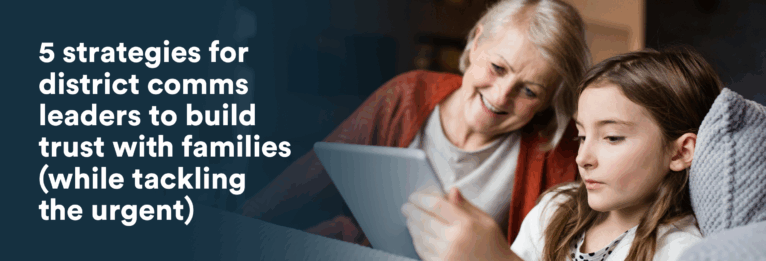Written by TalkingPoints
District Communications Leaders are the ultimate multitaskers.
They carry the mental load of everything happening across a district. Their communication tools are their lifeline to spread the word to staff, community members, and families. However, in the rush to disseminate messages, it’s easy to lose sight of what truly builds trust: two-way communication directly with families.
Trust is the foundation of successful family engagement strategies. When families feel informed and heard, they are more likely to get involved and positively impact student outcomes.
So, what is the key to balancing urgent communications and building two-way trust at the same time? These five family engagement strategies are a great place to start.
![]()
Discover more about these strategies by watching the webinar:
5 Strategies for District Comms Leaders to Build Trust with Families (While Tackling the Urgent)
![]()
1. Shift from communication to engagement with family engagement strategies
Strong family partnerships start by seeing communication through the family’s eyes. While updates about district matters are valuable, what families really want is a connection at the classroom level.
Families are looking for a way to interact and collaborate with the educators who work with their students every day. Those classroom-level conversations build relationships that can transcend through the school and district levels.
As the strategy name entails, classroom communication cannot just be an educator sending families updates. Relationship building only happens when families are given a way to engage back. You’ll know this strategy is working when families aren’t just reading updates, they’re starting conversations too.
2. Use tiered family engagement strategies for scalable impact
Once a family engagement solution for building those relationships is identified, it’s time to implement it within the district. A successful district-wide rollout starts with one meaningful step at a time.
Start with a subset of educators and families. Prove the value, gather feedback, and use those insights to guide the next phase. Each tier of implementation builds momentum and credibility.
It is important to work your way into full district-wide adoption to provide predictable engagement expectations for families. Those with multiple children, often across schools, benefit from a consistent engagement experience. When communication feels familiar and reliable, trust can grow.
3. Meet families where they are with thoughtful communication
The content of trust-building communication matters, but families being able to understand the content matters even more.
Even the most engaging messages won’t hit the mark if families can’t understand or consume what is being sent. Ensure the following engagement best practices are being followed to make every message count:
- Communicate via a channel that is accessible to families. Studies show text messaging is the preferred method of communication.
- Translate messages into families’ home languages.
- Provide text-to-speech and speech-to-text capabilities.
- Use a tool that explains U.S. education terminology for families that may not be familiar with the language.
The goal is simple. Provide families with equal access to information so they can properly support their students. When these family engagement strategies are paired with inclusive communication practices, families are more likely to feel seen, valued, and empowered to support student success.
![]()
Looking for a tool to help you implement these best practices?
Explore TalkingPoints’ award-winning communication and family engagement platform.
![]()
4. Evaluate real impact
To provide meaningful impact, district communication leaders should ask themselves two questions:
- Will staff and families adopt this communication and engagement strategy?
- Will it make a difference in student outcomes?
Families will need to feel that an authentic relationship is being built for this strategy to be a success. If they feel overwhelmed with constant updates, they may start tuning them out. On the other hand, too little communication can leave them feeling forgotten or disconnected.
The key to unlocking that balance is selecting the right engagement tool and giving educators the support they need to use it effectively. Only when that foundation is set, can the thoughtful interactions between educators, staff, and family support student outcomes.
5. Lead with purpose, not compliance
Throughout the implementation of these strategies, it is important to remember the purpose of family engagement. It isn’t about compliance or checking a box.
It’s about creating trust.
Once genuine trust is established, students can feel supported on all sides throughout their educational journey. Research shows that supported students lead to improved attendance and stronger academic performance.
District communication leaders have a lot on their plates. But building trust with families doesn’t have to be overwhelming. Following these family engagement strategies and focusing on opening authentic two-way communication capabilities between educators and families can be the ticket to strengthening relationships across the entire district.
![]()
Watch the full webinar to dive deeper into these five strategies.
![]()
Celebrating 10 years of partnership and impact
For a decade, TalkingPoints has supported students, families, and educators through the power of effective family-school partnerships. As an education technology nonprofit, our award-winning communication and family engagement platform has improved outcomes for districts and students across the country.
We connect 9 million+ educators, students, and family members annually and have facilitated more than one billion conversations—building trust, fostering relationships, and fueling student success. Named by Common Sense Education as “the best overall family communication platform for teachers and schools,” TalkingPoints drives measurable gains in attendance and academic achievement, backed by rigorous, causal research.
Join us in building a future where every child has the support they need to thrive.



